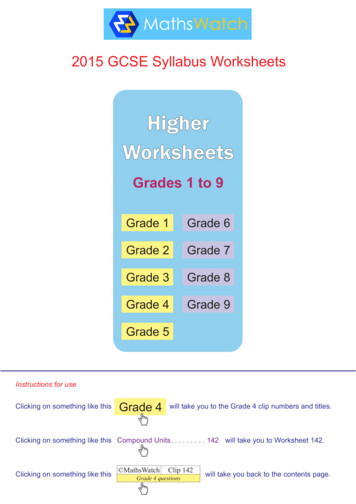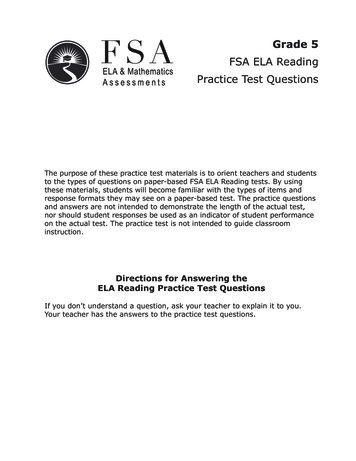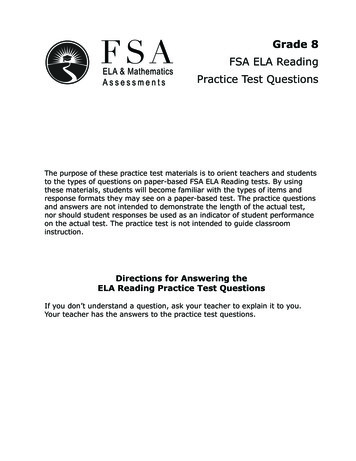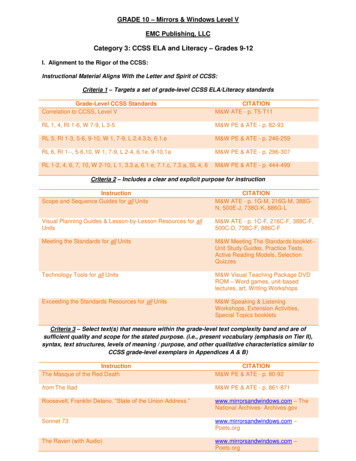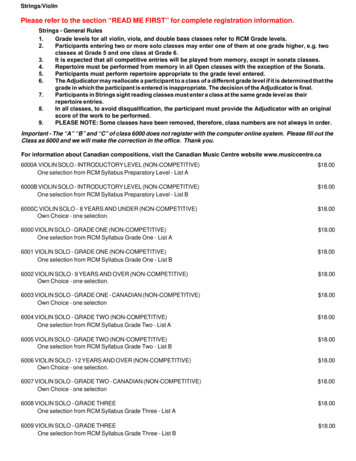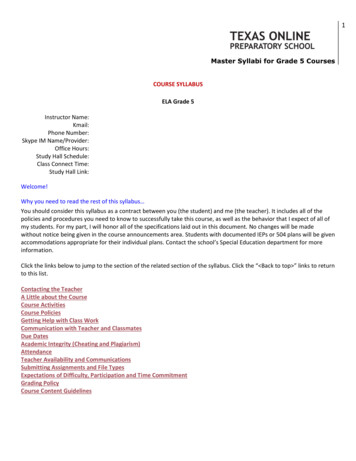
Transcription
1Master Syllabi for Grade 5 CoursesCOURSE SYLLABUSELA Grade 5Instructor Name:Kmail:Phone Number:Skype IM Name/Provider:Office Hours:Study Hall Schedule:Class Connect Time:Study Hall Link:Welcome!Why you need to read the rest of this syllabus You should consider this syllabus as a contract between you (the student) and me (the teacher). It includes all of thepolicies and procedures you need to know to successfully take this course, as well as the behavior that I expect of all ofmy students. For my part, I will honor all of the specifications laid out in this document. No changes will be madewithout notice being given in the course announcements area. Students with documented IEPs or 504 plans will be givenaccommodations appropriate for their individual plans. Contact the school’s Special Education department for moreinformation.Click the links below to jump to the section of the related section of the syllabus. Click the “ Back to top ” links to returnto this list.Contacting the TeacherA Little about the CourseCourse ActivitiesCourse PoliciesGetting Help with Class WorkCommunication with Teacher and ClassmatesDue DatesAcademic Integrity (Cheating and Plagiarism)AttendanceTeacher Availability and CommunicationsSubmitting Assignments and File TypesExpectations of Difficulty, Participation and Time CommitmentGrading PolicyCourse Content Guidelines
2Master Syllabi for Grade 5 CoursesContacting the TeacherIt is your responsibility to contact me with any questions you may have. Don’t wait until the last minute—when aquestion arises, ask it early. When you have questions about course content or assignments, post them in the Raise YourHand area. If you have private questions for me—for example, regarding a grade you received on an assignment—eithersubmit those to me by email or through your journal. Alternately, you can also visit me during Study Hall Hours, IM, orcall my office phone—see the top of the syllabus for this information.If technical difficulties prevent you from contacting me online, please call my office phone (listed above). If my number islong distance for you, leave me a message and I will call you back as soon as possible so I can pay for the call. Back to top A Little about the CourseWelcome to English and Language ArtsThis course provides structured lessons on composition, vocabulary, grammar, usage, and mechanics. Throughemphasis on spelling, students learn relationships between sounds and spellings in words and affixes. Lessonsare designed to develop comprehension, build vocabulary, and help students become more independent andthoughtful readers.LANGUAGE SKILLS Composition -- Students practice writing, from planning to proofreading, as they write a memoir, an editorial, aresearch paper, a business letter, and moreGrammar, Usage, and Mechanics -- Students learn about parts of speech, punctuation, and research skills. Theycontinue sentence analysis and diagrammingVocabulary -- The Vocabulary Workshop helps students enrich their vocabulary, develop word analysis skills, andprepare for standardized testsSpelling -- Students learn sound-symbol relationships and spelling patterns, identify affixes and how they affectthe meaning of words, and recognize base words and roots in related wordsLITERATUREStudents analyze, compare, and creatively respond to a variety of works. The emphasis is on classic works, includingtales of Robin Hood and St. George; selections from Don Quixote and Shakespeare's The Tempest and A MidsummerNight's Dream; "Rip Van Winkle" and "The Legend of Sleepy Hollow"; and Sherlock Holmes mysteries. Students readworks of nonfiction, as well as four novels (selected from a long list of such classics as Pippi Longstocking, Call It Courage,and The Lion, the Witch, and the Wardrobe).Course length: Two SemestersMaterials: Standard Curriculum Items Kit Box B (box in which materials are packed)White Dry-Erase BoardClassics for Young Readers, Vol 5BClassics for Young Readers, Vol 5AAmerican Tall Tales
3Master Syllabi for Grade 5 Courses Paddle to the SeaExercises in English, Grade 5 (Level E)Bard of Avon: The Story of ShakespeareCurious CreaturesVocabulary Workshop - Gr. 5 (Blue)I Didn't Know ThatWriting in Action, Volume EWriting in Action, Volume FDon QuixoteAmerican Lives & LegendsKeyboarding CDWord Processing BookTest Ready Longer Passages Book 5Test Ready Lang Arts, Book 5Title and AuthorLexile LevelA Lion to Guard Us, by Clyde Robert BullaStone Fox, by John Reynolds GardinerSarah, Plain and Tall, by Patricia MacLachlanHenry Huggins, by Beverly ClearyCharlotte's Web, by E.B. WhiteFrom the Mixed-up Files of Mrs. Basil E. Frankweiler,by E.L. KonigsburgLi Lun, Lad of Courage, by Carolyn TreffingerIn the Year of the Boar and Jackie Robinson,by Bette Bao LordA Wrinkle in Time, by Madeleine L'EngleThe Bronze Bow, by Elizabeth George SpeareLittle House on the Prairie, by Laura Ingalls WilderThe Book of Three, by Lloyd AlexanderTuck Everlasting, by Natalie BabbittThe Sign of the Beaver, by Elizabeth George SpeareWalk Two Moons, by Sharon CreechWar Comes to Willie Freeman,by Christopher and Lincoln CollierThe Cricket in Times Square, by George SeldenMrs. Frisby and the Rats of NIMH, by Robert C. O'BrienMy Side of the Mountain, by Jean Craighead GeorgeCall It Courage, by Armstrong SperryJohnny Tremain, by Esther ForbesRamona Quimby, Age 8, by Beverly ClearyThe Fellowship of the Ring, by J.R.R. TolkeinPippi Longstocking, by Astrid LindgrenThe Hundred Dresses, by Eleanor EstesDragonwings, by Laurence 0780790810830840860860870870870
4Master Syllabi for Grade 5 CoursesShiloh, by Phyllis Reynolds NaylorCaddie Woodlawn, by Carol Ryrie BrinkOld Yeller, by Fred GipsonRoll of Thunder, Hear My Cry, by Mildred D. TaylorThe Dark Is Rising, by Susan CooperThe Lion, the Witch, and the Wardrobe, by C.S. LewisBud, Not Buddy, by Christopher Paul CurtisWhite Fang, by Jack LondonAnne of Green Gables, by Lucy Maud MontgomeryThe Door in the Wall, by Marguerite de AngeliIsland of the Blue Dolphins, by Scott O'DellBen and Me, by Robert Lawson20,000 Leagues Under the Sea, by Jules VerneHound of the Baskervilles, by Arthur Conan DoyleSwiss Family Robinson, by Johann Wyss1260The Incredible Journey, by Sheila 10301090 Back to top Course ActivitiesCourse activities may include:Reading online text and transcriptsViewing moving and static images andstreaming videoListening to audio recordings andpronunciationsWatching linear and interactive animations andsimulationsCompleting hands-on and virtual activitiesGraded assignments may include:Online or paper-based worksheets and practicesetsQuizzesExams (unit, semester and final)Blog postsParticipating in threaded discussions withteachers and fellow students in a section,cohort, or groupTeacher announcementsCompleting online self-check exercisesReading and completing teacher-createdinstructional materialsWork samplesThreaded discussionsEssays, research papers, and other writingassignmentsPresentationsAll graded assignments are either automatically scored by the K12 Learning Management System, teacher evaluatedsurvey, teacher evaluated Blog survey, and Study Island assignments (teacher score evaluation or teacher graded withinthe site). Back to top Course PoliciesAttendance and Activity
5Master Syllabi for Grade 5 CoursesStudents are expected to log into this course daily. While the length of time that students spend working onassignments may vary, the expectation is that you will spend approximately 60 to 75 minutes on courseworkeach day.Daily Student ResponsibilitiesEvery time you enter the course and before completing any class work: Read any announcements I posted since the last time you entered the course. Review the Calendar to see what lessons and assignments you are to complete that day. Look at the Course Checklist at the bottom of the Course Home page to review where you left off in thecourse content since you last logged in. Complete all lessons and assignments (both graded and nongraded) as indicated on your coursecalendar before the end of the day. Submit assignments to me through the Kmail tool, unless they are scored by the computer.Before you log out of the course: Make sure you have completed all of the work for the day, including the nongraded lesson work. Back to top Getting Help with Class WorkThis is going to be a challenging course. When you encounter difficulty with course content: First: Visit the Raise Your Hand area in the class blog. Check to see whether another student has askedthe same question and whether I’ve already answered it. If not, then post your question and check backlater. I will answer questions posted here at least twice daily throughout the day. Next: Visit me in Office Hours/ Study Hall Hours, held daily (See my schedule at the top of the syllabus). If it is urgent or private: Send me a k-mail or contact me using the phone number or online screen name(IM) at the top of this syllabus.For technical questions (You can always ask the teacher first.), troubleshooting, or online assistance:http://help.k12.com/ Back to top Communication with Teacher and ClassmatesAlthough you won’t be able to send k-mail to other students, you will be communicating with other students throughthe community area outside of the course, the class blog and through threaded discussions within the blog. In addition,students often form friendships while in the course together. When this happens, students often share email addressesor instant message names. You will need to have your parent/guardian approval to share this information.Some things to keep in mind when communicating with other students: Respect the privacy and wishes of your fellow students. Flaming, spamming, bullying or other unwanted contact including inappropriate message content orattachments will be considered a breach of this policy. Infractions may result in disciplinary action by theschool administration.
6Master Syllabi for Grade 5 CoursesNetiquette: http://www.k12.com/terms-of-use Back to top Due DatesThe course calendar and my weekly announcements will list which lessons and assignments you need to complete eachday. You’ll also find assignment due dates in “The Trailblazer” sent in kmail. It is important that you stick to the courseschedule indicated on the calendar and in the announcements as well as the due dates for each assignment. Staying onschedule allows you to learn along with your classmates. This is especially important as we all learn together through thethreaded discussions in the course. Back to top Academic Integrity (Cheating and Plagiarism)Students who submit work as their own, when it is not wholly and completely their own, are guilty of cheating and/orplagiarism and will receive a grade of zero on the entire assignment.Assisting other students in cheating or plagiarism is also considered academic dishonesty and students who do this willreceive a grade of zero on their assignment submission as well.The first time a student fails to cite the source of information in an essay or research paper, he/she will be advised ofproper citation methods. Further infractions will result in the student receiving a grade of zero on the item orassignment.Students who are found guilty of cheating or plagiarism more than once will be referred to the school administration forbreach of the school’s Behavior Code.I may use a technology that helps to prevent cheating for some tests. Before these tests, you will be prompted to installa small piece of software on your computer. You will be required to install this piece of software before taking theassessment. Once you access the test, you will be unable to copy, paste or open new browser windows or programsduring the assessment. If you experience any difficulty, contact K12 Customer Care for assistance. Contact meimmediately if Customer Care cannot resolve your issue.K12 Privacy Policyhttp://www.k12.com/privacy-policyK12 Copyright Policyhttp://www.k12.com/copyright-policy Back to top AttendanceRegular and daily attendance is required:You must log into the course and complete the scheduled work every school day.Unless otherwise specified, course log in is required even when assignments occur offline as you are expected toreview any updated announcements, What’s New items and threaded discussion responses daily.
7Master Syllabi for Grade 5 CoursesYou should expect to spend 30 to 75 minutes each day reading, responding, and completing other activities bothonline and offline.If you know you will not be able to log into the course on any given day, please contact me immediately by kmail. If you encounter technical difficulties, contact me by phone. If you do not contact me before missing anactivity, you can expect to hear directly from me.Students who continually fail to enter the course and show progress will be referred to the schooladministration. Back to top Teacher Availability and CommunicationsAfter the first two weeks of school, you’ll have a lot more freedom in your daily schedule. This goes for teachers as well!This means that, although we’re both working in the course every day, we may be working at very different times of theday. When you and I happen to be online and working at the same time, I might not be immediately available. Most ofmy day is spent responding to student questions in the Raise Your Hand area, grading work samples and returningassignments, and answering k-mails and phone messages. Feel free to contact me when needed, but please understandthat I might be in the middle of one of these tasks, or helping another student at the time. You may need to leave me amessage if you call, or wait for a short time to receive answers online. Of course, I am always available during my officehours/ study hall hours, which are listed at the top of this syllabus.I will read and respond to questions in the Raise Your Hand areas of the course several times throughout the day. Youcan expect an answer to a question posted in this area in less than one school day. Email questions and phone messageswill be returned no later than one school day.If you would like to schedule time for a private conference, please request these at least three to five days before theday you are available. The more notice you provide me, the more likely I can be available at a time that is best for youand/or your parent/mentor. Back to top Submitting Assignments and File TypesNames of files you submit Files you submit to me through kmail should have a filename that indicates which assignmentit is, followed by your first initial and last name. You may wish to use “U” and “L” to indicate which unit and lesson it is,or simply shorten the actual title of the assignment. Some examples include “U4L3RSmith” (unit 4 lesson 3 for RobertSmith) or “PersuaEssyRSmith” for Robert Smith’s Persuasive Essay.Always use kmail I will only accept teacher-graded assignments submitted through kmail. If for some reason you areunable to submit assignments through kmail, or assignments you submit are not being returned to you, contact meimmediately. We will make alternate arrangements for you to get the assignments to me for grading.File type and size At all times, attempt to keep the size of files you submit less than 3 MB.Unless otherwise indicated in the assignment directions, the only file types you should submit to me are .doc, .txt, and.tif. Assignments in other formats will be returned for resubmission.
8Master Syllabi for Grade 5 CoursesClass Blog There is an area we will use as a class for collaboration and sharing. I will occasionally upload documents tothis area for you to download for use in class. Students can also upload files to this area. Please refrain from uploadingfiles there unless you have asked my permission first. Students who upload files without permission will be referred tothe administration for breaking the school’s Acceptable Use Policy.Study Island Study Island assignments will be scored by the computer or teacher scored. When submitting a teacherscored assignment such as a final draft writing assignment, you must officially turn the piece in for grading in order for itto be scored.Surveys Surveys will be evaluated by the teacher. Make sure you complete any surveys that you are assigned Back to top Expectations of Difficulty, Participation and Time CommitmentStudents often find that going to school online takes longer and is more difficult than going to school in a traditionalsetting. Be prepared for this course and online schooling in general to be a little more difficult than you might expect. Ifyou are not spending at least 60 minutes on this course each day, you’re probably not doing enough to pass the class. Ifthis is happening, make an appointment to meet with me or visit me in Office Hours so we can review what you aredoing each day. If you need help in working out a personal schedule, staying motivated or creating an effective homelearning environment, contact your advisor. This person is an expert at helping students with these concerns! Back to top Grading PolicyEach week I will ask you to submit a work sample from non-computer graded work, the additional activities locatedunder unit resources, teacher evaluated survey, teacher evaluated Blog survey, and Study Island assignments (teacherscore evaluation or teacher graded within the site). These work samples are critical for my understanding your skills andareas of strengths and weaknesses. Some work samples may be audio or video recordings, essays, examples ofdiscussion posts and you will know the required submission by Tuesday of each week. You will notice that some types ofassignments are worth more points, overall, than others. For example, it is very possible to take only computer-scoredquizzes in this course and get an A on each one, but still fail the course. This would happen because computer-scoredquizzes make up a small percentage of the total points in the course.When an assignment is to be submitted to me as an electronic file, I will accept these through kmail, survey, or StudyIsland. If you have technical difficulties using kmail, contact me immediately to make other arrangements.I will grade and return all teacher-scored assignments within five school days and sooner whenever possible. Whenthese assignments are returned, you are expected to open them and read the feedback I provide directly in the files. Usethis feedback to improve your work on future assignments.Threaded Discussions on the Class BlogGrades are based on quality and timeliness. Responses should be well-written (Use the spell check tool.) and clearlyaddress the issue being discussed. Stay on topic.
9Master Syllabi for Grade 5 CoursesThreaded discussions usually last about three days. You are expected to respond to the original question or prompt onthe first day, then read and respond to others’ postings on the second day. On the third day, you should respond toothers’ responses to your original post.CATEGORYInitial Response Responded to the Responded to theto Promptinstructor's topic instructor's topicon time.one day late.Reply to Peers – Responded to two Responded to two1st Roundpeer postings on peer postings onetime (within two day late (withindays).three days).Additional Reply Responded to at Responded to oneto Peers – 2nd least one moremore peer one dayRoundpeer on time.late.ContentHigh-qualityCoherent contentcontent thatthat reflects basicreflects goodunderstanding ofconceptualmost contentunderstandingintroduced in theand completion of course.assignedcoursework.Responded to theinstructor's topictwo days late.Responded to theinstructor's topicmore than two dayslate.Responded to one Responded to onepeer posting onpeer posting onetime (within twoday late (withindays).three days).Responded to one Responded to onemore peer two days more peer morelate.than two days late.Acceptableunderstanding ofcontent with someminormisconceptionsrelated to coursecontent.Marginalunderstanding ofcontent withobviousmisconceptionsrelated to coursecontent.Did not respond tothe instructor'stopic.Did not respond toany peer postings.Responded to noneof the peers whohave postedcomments to you.Content does notdemonstrateunderstanding ofcourse content.Quality PostStudent’sStudent’s comments Student’s comments Student’s comments Student did notcomments addadd moderately to add minimally todo not add to the participate at all inAppropriatesignificantly to the the discussion bythe discussion.discussion.the threadedLength discussion bysuggesting solutions, Student does notPosting is simple: "I discussion.30–75 words of suggesting other pointing outsubstantiate anyagree" or "Yes" orwell-written text solutions, pointing problems, or even comments made"No."out problems, or respectfullywith reasoning oreven respectfully disagreeing. Student source citation.disagreeing.does notStudent alsosubstantiate anysubstantiates any comments madecomments made with reasoning orwith reasoning or source citation.source citation.Grade ReportingYour gradebook will always display points earned vs. point’s possible as well as percentage grades. I will also provideletter grades that correspond to the percentage grades.
10Master Syllabi for Grade 5 CoursesAssignments will be graded and (in most cases) returned to you in five school days. Grades will appear in your onlinegradebook, and feedback to your work will most often be included directly inside the files that I return to you. Back to top Course Content GuidelinesLITERATUREComprehension Strategies Ask questions and support answers by connecting prior knowledge with information found in, and inferred from,the textMake connections to personal experiencesRecall major points in the text and make and modify predictionsSummarize readingsComprehension Skills Recognize the author's purposeIdentify the speaker or narrator in a selectionIdentify and explain cause and effect in literary selectionsCompare and contrast across selections and genresDraw conclusions using evidence from the textMake and explain inferences, using evidence from the textIdentify problems faced by characters in stories, and their solutionsDistinguish between fact and opinionIdentify the main idea and supporting details of a paragraph or selectionRecognize story elements: character, setting, plot (conflict and resolution), themeInformational Materials Use titles, tables of contents, chapter headings, glossaries, and indexes to locate information in textFollow multiple-step written instructions (e.g., how to use computer commands)Locate information in charts, diagrams, maps, captions, illustrations, and photosLiterary Response Recognize different genres: biography, drama, legends, historical fiction, fiction, nonfiction, and poetryDescribe characters, using examples from the textDescribe how a character changes over the course of a storyCompare and contrast tales from different culturesPoetry Identify line, stanza, and rhymeIdentify and use metaphors and similes
11Master Syllabi for Grade 5 Courses Identify and analyze how a poet uses language to appeal to the senses, create imagery, and set toneRecognize literary techniques such as personification, hyperbole, alliteration, and onomatopoeiaListening and Speaking Strategies Retell, paraphrase, and explain what a speaker has saidRead prose and poetry aloud with fluency, rhythm, and expressionConnect and relate prior experiences, insights, and ideas to those of a speakerLANGUAGE SKILLSGrammar, Usage, and MechanicsSentences Identify and form four kinds of sentences: declarative, interrogative, imperative, and exclamatoryUse the appropriate end punctuation mark for each kind of sentenceIdentify the subject and predicate of a sentenceIdentify compound subjects and predicatesIdentify direct objectsAnalyze and diagram simple sentencesPunctuation and Capitalization Use periods after initials and some abbreviationsUse postal abbreviations for states, without a periodUse commas in direct addressUse commas with yes or noUse commas separating words in a seriesUse commas in direct quotationsUse apostrophe to show possessionUse apostrophes in contractionsUse quotation marks for direct quotationCapitalize first word in a sentence, proper nouns, and names of months, days of the week, and holidaysCapitalize the first word in a direct quotationCapitalize abbreviations of proper nouns, initials, and important words in titlesNouns Identify proper and common nounsIdentify singular and plural nouns, regular and irregularForm singular and plural possessive nounsIdentify nouns used as subjects and direct objectsPronouns Identify and understand usage of personal pronounsIdentify and use singular and plural pronouns
12Master Syllabi for Grade 5 Courses Use pronouns as subjects and direct objectsDistinguish correct usage ofI and me, and we and usIdentify and use possessive pronounsAdjectives Identify adjectives and their functions (describe a noun, tell what kind, tell how many)Identify and use possessive adjectivesUse the correct form of an adjective to compare two nouns, or to compare three or more nounsUse comparative forms of good and bad (better and best, worse and worst)Identify and use demonstrative adjectives (this, that, these, those)Identify a, an, and the as articlesVerbs Identify verbs in a sentenceIdentify and use action verbs, being verbs, and linking verbsIdentify helping and main verbs in sentencesIdentify and use regular and irregular verbsIdentify and form principal parts of verbs (present, present participle, past, past participle)Use correct forms of:begin, beginning, began, begunbreak, breaking, broke, brokenchoose, choosing, chose, chosendo, doing, did, doneIdentify and use simple tenses: present, past, futureIdentify and form the present progressive tenseIdentify and form the past progressive tenseUnderstand that a subject and verb must agree in number (singular or plural)Correctly use:is, am, are, was, weredo and doesthere is and there areAdverbs Identify adverbs and understand their functions (modifies a verb, adjective, or another adverb)Identify and use adverbs of time, place, and mannerUse correct forms of adverbs to make comparisonsUse correct forms ofgood and well; no, not, and neverLetter Writing Identify and correctly write the parts of a social (friendly) letterAddress an envelope
13Master Syllabi for Grade 5 CoursesWord Study Skills Understand how to locate words in a dictionary and use dictionary entriesReplace words with synonymsIdentify antonyms to given wordsUse a thesaurus to find synonyms and antonymsUse the following homophones correctly:to, too, twotheir, there, and they'reVocabulary and Word Study Understand and apply the definitions of given wordsWrite sentences to answer questions on a reading selection that uses the words in contextWrite original sentences that use words correctly in contextMake connections between words and ideasIdentify synonyms and antonyms of given wordsHANDWRITINGHold pencil correctly Write lowercase and uppercase cursive letters correctly on standard-ruled paperSpace letters, words, and sentences properlyCopy short passages legibly and accuratelyLISTENING AND SPEAKING Recite a poem from memory, read an original composition, and read aloud a brief passage from a favorite bookUse techniques for effective oral presentations (e.g., stand straight and tall, keep your hands at your sides, speakwith expression in a loud, clear voice, use complete sentences and proper grammar)Maintain purposeful discussion (agree and disagree constructively, state ideas clearly and fully using completesentences and proper grammar, synthesize and build on others' ideas, explain and defend ideas)Give precise directions and instructionsCOMPOSITIONWriting as a Process Understand and practice writing as a process (prewriting, drafting, revising, proofreading, publishing)Writing Guided Journal Entries Distinguish diaries from journalsUse a journal to list possibilities for topics to write aboutDescribe a place or object in a journal entryRespond in the journal to a cartoon or other clippingFind and record expressions and quotations in the journal
14Master Syllabi for Grade 5 Courses Identify four kinds of paragraphs: factual, descriptive, persuasive, narrativeDevelop paragraphs with a topic sentence and supporting details that relate to the topicPlan and write a short essay based on a journal entryWriting a Report Choose and narrow a topic for a reportFind sources for a reportGather information using library and Internet sourcesCompile a bibliographyOrganize facts into an outlineWrite an effective introduction and conclusionRevise the report to improve content, organization, clarity, and word choicesProofread and publish the reportWriting a Book Review Analyze a sample book reviewSummarize the book to be reviewedGather information about the authorEvaluate the plot, characters, and settingPrepare an outline for the book reviewWrite, revise, and proofread the reviewWriting to a Prompt Examine different kinds of writing prompts to determine what kind of writing to doUse the writing process--planning, writing a first draft, revising, and proofreading—to write to a promptPractice writing in response to narrative, expository, persuasive, and descriptive promptsWrite to a prompt in a simulated test situationWriting Poetry Practice poetic techniques to make any writing more active, imaginative, and vividIdentify and use imagery, rhythm, alliteration, onomatopoeia, and refrainsWrite and revise poems in prescribed formsWrite and revise poems in free verse and in rhymeWriting a Persuasive Paper Distinguish fact from opinionSupport arguments with facts, experiences, and reasoningAnticipate and respond to opposing argumentsFind and us
Master Syllabi for Grade 5 Courses 4 Shiloh, by Phyllis Reynolds Naylor 890 Caddie Woodlawn, by Carol Ryrie Brink 890 Old Yeller, by Fred Gipson 910 Roll of Thunder, Hear My Cry, by Mildred D. Taylor 920 The Dark Is Rising, by Susan Cooper 920 The Lion, the Witch, and the Wardrobe, by C.S. Lewis 940 Bud, Not Buddy, by Christopher Paul Curtis 950



